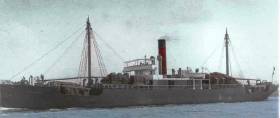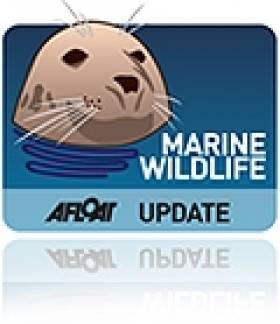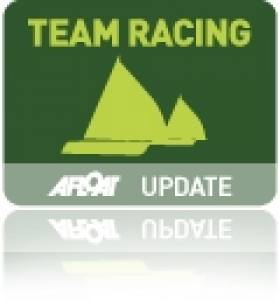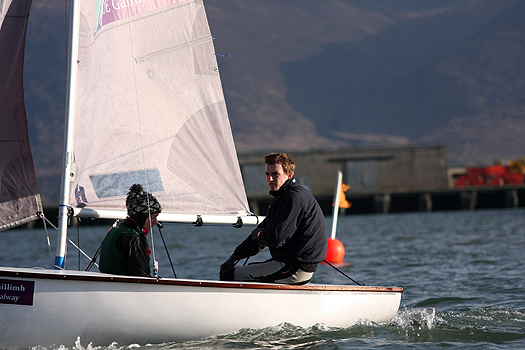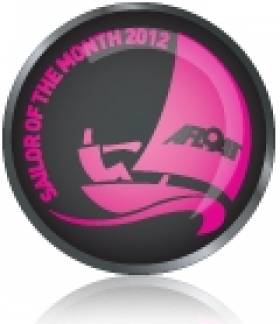Displaying items by tag: Tralee Bay
An Island Nation – But Not Yet A Maritime One!
I love Irish history. It is the story of the Irish people, living in an island nation. But I have always wondered about a maritime, a shipping aspect of the Easter Rising, the commemoration of which has raised the profile of our evolution as an independent country. And that is – would it actually have been possible for the AUD, the German ship with weapons and ammunition for the Irish Volunteers, by arrangement with Roger Casement, to have landed its cargo in Tralee Bay, which is the accepted historical conception of that part of the plans for the Rising.
I have always wondered about the challenge and difficulties of getting 20,000 rifles, 10 machine guns and 3.5 million rounds of ammunition off that ship in the conditions and shipping facilities of Tralee Bay and the probably only realistic landing site at Fenit in 1916.
Was it to have been done at Fenit? In the facilities there for unloading in 1916 would that actually have been possible? Was it thought that the cargo might be got off into open boats in the Bay?
I got my opportunity to ask that question of an expert on the period last weekend, Dr. John Treacy, who was recently awarded his Ph.D. from Mary Immaculate College in Limerick for his doctoral thesis about the Naval Service.
He answered me very directly: “I would say absolutely not.”
He had a lot more to say about the AUD and the plan for it to provide weaponry for the Volunteers when I interviewed him at a seminar which underlined the huge public interest in Irish maritime affairs. “Revolution on an Island -The Maritime Aspects of the 1916 Rebellion,” was organised by the Irish Maritime Forum. It was booked out. People attended from all over the country. There was even a waiting list for places at the National Maritime College in Ringaskiddy on the edge of Cork Harbour where it was held.
Dr. Treacy spoke on ‘The Silent Shore – The Attempt to land arms at Banna Strand from the AUD.” It is a fascinating part of Irish history and the maritime involvement. If you have any interest at all in our history, I urge you to listen to him below on my programme, THIS ISLAND NATION.
It was also an unusual experience for me at that seminar to find myself being quoted at the outset. It was for my description of Ireland as an “island nation” which is accepted by the Forum, which is an independent think-tank on maritime matters. But the Forum had a qualification – “Ireland is not yet a maritime nation”
You can hear more about this from retired Naval officer, Capt. James Robinson, who discusses it with me on behalf of the Forum. Not a lot has been heard about the Forum in public, but this seminar was a revelation.
Simon McGibney, the new Commodore of the Irish Cruiser Racing Association, talks to me about his plans for this year’s sailing and the retirement of one of the country’s longest-serving lifeboatmen, from the RNLI Rosslare Station, is reported while there is also good advice on the programme about using vehicles to launch and recover boats from slipways in view of the Buncrana tragedy.
THIS ISLAND NATION reports on the marine traditions, culture, history and modern maritime developments of our island nation. I hope you enjoy it and would welcome your comments. You can Email to: [email protected]
Stranded 'Whale' Perishes In Tralee Bay Shallows
#MarineWildlife - The Irish Examiner reports that a six-metre cetacean that prompted a mass rescue effort when it beached in Ballyheigue in Co Kerry earlier this week has died in the shallows.
The marine mammal, as yet unidentified but thought to be a large dolphin or small whale, drew crowds to the beach on Tralee Bay when it stranded in low water on Monday evening, according to Independent.ie.
Locals joined Ballyheigue Inshore Rescue in an attempt to haul the animal out to deeper water, with as many as 20 people involved in the operation.
But their efforts were for naught when the cetacean refused to swim out into the bay and was later seen thrashing its tail in the shallows.
It was hoped that the animal would eventually swim out with the tide, but was reported dead yesterday.
Samples are due to be taken by the Irish Whale and Dolphin Group to determine its species and condition.
The Irish Examiner has more on the story HERE.
#ICRA – Pat Kelly's J109 Storm II from Howth Yacht Club tops the leaderboard of the biggest IRC class after two heavy weather races in the opening day of the 2013 ICRA National Championships.
Three J109 designs are in the top five overall, but both Paul O'Higgin's Corby 33 Rockabill V from the Royal Irish Yacht Club and the new Xp33 design Bon Exemple sailed by O'Higgin's club–mate Colin Byrne break the J109 dominance, and lie second and third respectively tonight.
There was a thumbs–up from the 60–boat fleet moored at Fenit marina tonight for Tralee Bay Sailing Club's handling of the opening day with good race management and great conditions with sunshine and winds gusting to 25 knots.
The club, of course, is well used to giving a warm welcome to sailors, they’ve hosted events on all levels from Club to world championships on this beautiful part of Ireland's coast; the most south–westerly port in Europe.
Kelly's 2011 ICRA Boat of the Year has a one point lead over O'Higgins. In turn O'Higgins, who placed third in IRC one at the 2012 ICRA championships, has a single point over Byrne in a scheduled six race series with a twist – this is a no discard event.

The new Xp33 – with boat speed doctor Jochem Visser onboard – lies third overall in class one. Photo: Bob Bateman

Rockabill V, powering upwind, lies second in class one. Photo: Bob Bateman
There was disappointment for Denis Hewitt's Raptor again in Tralee Bay today. The Dublin Bay boat lost its mast the last time the ICRA Nationals sailed here in 2009 and today rigging issues also forced their withdrawal but with rig still intact the Royal Irish crew are ready for race three tomorrow.
In division 2 IRC, Nigel Bigg's Checkmate XV from the Royal St. George took two wins in the fresh conditions and leads the modified Half tonner King One skippered by Dave Cullen from Howth YC. The vintage half–tonner, that was a runaway winner at last year's Ramsgate week, took two seond places to be three points clear of former WIORA champion Ray McGibney's Dis-A-Ray from Foynes Yacht Club.
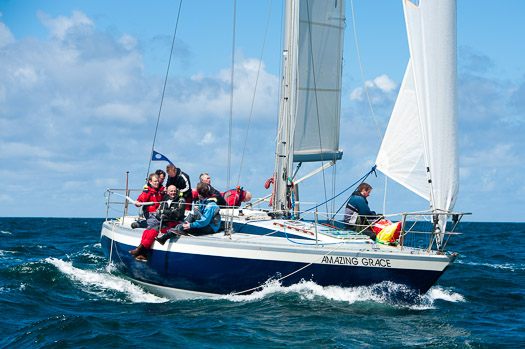
This week's Dun Laoghaire–Dingle race winner, Amazing Grace from the host club, is back in action in class two. Photo: Bob Bateman
There was no local advantage for Brian O'Sullivan and Frances Clifford's Amazing Grace in the opening race. Monday's winner of the Dun Laoghaire to Dingle race 'ploughed a neighbour's field' in race one but took fifth in race two.
In division 3 IRC, another Royal Irish Yacht, Barry Cunningham's Quarter tonner Quest, took two race wins from the Cove Sailing Club entry Illes Pitiuses that is counting two seconds. Illes Pitiuses is a modified Quarter tonner brought back from the Mediterranean by owners Jason and Dominic Losty in 2011.
Third in this ten–boat fleet is Tralee Bay's own Jaguar, a J24 design, skippered by Gary Fort.
Somewhat predictably, Antix skippered by Anthony O'Leary, who has just announced his intention to contest New York's Invitational Cup for a third time, got off to perfect start in class zero taking two wins in the five boat fleet. Second is ICRA commodore Nobby Reilly's Crazy Horse with Martin Breen's Reflex 38 lying third. It is perhaps a sign of the times we live in, that just five boats are in this division.
O'Leary's Club mate Jump Juice (Denise Phelan) suffered a man–overboard in the opening race. The crew man was recovered by RIB.
Racing continues tomorrow in day two of three and more strong winds are forecast.
Full results here.
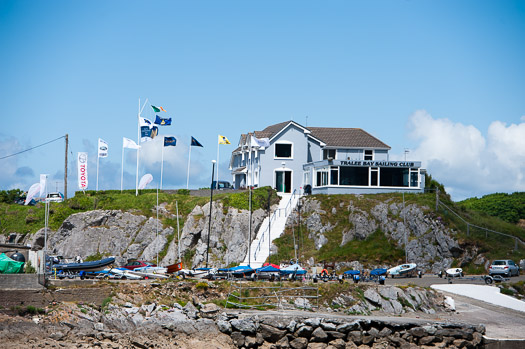
The ICRA fleet has given a thumbs up to TBSC Commodore Pat Daly and his team after day one of the competition. Photo: Bob Bateman
ICRA Class Two is One to Watch at Tralee Bay Championships
#icra – ICRA Class 2 is building to become the strongest class and most widely representative of all coasts at June's ICRA Nationals at Tralee Bay SC writes Barry Rose.
With entries already received from likes of Paul and Deirdre Tingle from Royal Cork who are bringing their new Corby 25 Alpaca (ex Allure ex Kinetic) a boat with a terrific reputation at ICRA Nationals.
The Tingle's will be taking on fellow Corby 25 Tribal (ex Yanks and Franks) Liam Burke from Galway Bay and Ray Mc Gibney's Disaray from Foynes Yacht Club and Strictly Business (Ferguson Kelleher) from Tralee Bay.
King One Dave Cullen's Half Tonner from Howth Yacht Club will travel together with Nigel Biggs Checkmate XV from Royal St George to lead a Dublin Challenge.
Egalite David Griffins Dehler 34 from Cliften will likely be joined by Martin Reilly's Half Tonner Harmony (also originally optimised by Nigel Biggs) and Conor Ronan's well prepared Corby 26 Ruthless both from Sligo Yacht Club.
It is also hoped Royal Cork Admiral Peter Deasy and his team on Bad Company will compete to build on their success at Cork Week.
Class 0 already has the likes of Norbert Reilly's Mills designed Crazy Horse sailing this time with a father and son combo and Conor and Denise Phelan's Ker designed Jump Juice being joined by Anthony O'Leary's Ker 39 Antix and George Sisk's Wow so the basis of a most competitive fleet is also building nicely in this class.
Priority berthing in Fenit Marina will be given to early bookings.
Update from Brian O'Sullivan at Tralee Bay SC
1. April 27th: end of early entry discount.
2. IRC and ECHO Certificates: have you got your certificates sorted out, or
even applied for at this stage? this process can take several weeks, so make
sure you get your application in as soon as possible....
3. Accommodation: There are still some houses available for letting at very
reasonable rates in Fenit village, but they are getting scarce. The
committee have sought out whatever is available and the last few houses will
be listed on the website very shortly, so keep an eye on this. Don't forget,
the Brandon Hotel also, have a few rooms left at unbelievable rates - check
out our website for details - www.traleebaysailingclub.com
4. Crew: for owners and skippers - it is time to get your crew together. Get
some early training in, get rid of the cobwebs and build up some team
spirit. Only 8 weeks to go!!!
5. Boat Movements: if you have to bring your boat to the event - have you
lined up a delivery crew and a return trip crew? Time to organize this now -
make sure you have plenty crew, as inevitably, some will drop out in the
last minute for whatever reason! If you are struggling to get crew, contact
us and we will help from our pool of skippers and crew who have volunteered
for these delivery trips. Email us on [email protected] for
details.....
6. June 12th: WIORA commences...........
7. June 13th: ICRA commences............
Guys and girls: start getting your ducks in a row!!!!! Get entries with
PAYMENT in to avail of priority berthing in Fenit Marina!!!!
Limerick Capture College Sailing Championship
#teamracing – Three days of great racing on Tralee Bay, snatched from under the decidedly unsettled Patrick's Day weekend weather, saw the annual Irish Universities Sailing Association (IUSA) team championship raced at full pressure from March 15th to 17th writes WM Nixon. University of Limerick (UL) took the title from University College Dublin (UCD) in a cliff-hanger finish for the Gold Fleet, while University College Cork 1 (UCC 1) topped the Silvers. And in a healthy geographical spread of champions which augurs very well for the growing strength of college sailing in Ireland, the Bronze Fleet was won by Queens University Belfast (QUB).
Traditionally, St Patrick's Day is when the keener Irish sailors take the winter covers off their boat. But the university year dictates that all college racing is done in the off season, and most of the 26 teams which descended on Tralee with snow and northerly gales forecast had already put in several team racing events in 2013.
They were rewarded by Tralee Bay having some of the best weather going in all Ireland for the long weekend. And with Commodore Pat Daly of TBSC heading up the support effort from a host club which is noted for its hospitality (and that in Kerry, which is Ireland's Hospitality HQ), the event went in great style, with 196 races completed to provide a comprehensive awards list.
Hosting club ULSC had its noted helm Robert O'Leary stand aside from sailing duties in order to put through the organizing of this hugely demanding series, and the Limerick college were supported in their administrative efforts by sponsorship from Ulster Bank, while Banna Beach Resort just up the Kerry coast from TBSC's base at Fenit were able to row in with accommodation support towards housing a total of 156 sailors.
There was an international element to the event, as the Scottish Universities Sailing Association (SUSA) sent a representative selected squad. But in the end, all the trophies stayed on the island of Ireland after three days of varying but sailable weather. The format meant that the Bronze fleet were decided first with QUB captained by Jack Alexander-Gebhard taking the title, and then in the Silvers UCC 2 captained by Robin O'Mahony had the best of it from UL2 captained by Peadar O'Suillebhan.
Winning University of Limerick captain Ross Murray on Tralee Bay - he is also the current IUSA Sailor of the Year Photo: Cian Gallagher
In the Gold Fleet, UCC 1 (Rob Lehane captain) placed third, then in the final between UCD (captain Simon Doran) against UL captained by IUSA Sailor of the Year Ross Murray for best of five, it went to the wire with UL taking it on the line for three out of five wins.
With the team racing decided, this marks the conclusion of what could be called the college numbers game for 2013, although the UL team now have to go to England for the British Universities Team Opens at the end of April. But meanwhile elite crews are being selected by each university for the Irish selection trials for the Student Yachting Worlds in France. The selection will be a three day format, racing the ISA SailFleet J/80s (based this year in Howth) on April 6th, 13th and 20th. Interest is intense, as the Worlds will also be raced in J/80s, and Ireland will have two places. UCD well be there as of right, as current world champions, so there'll be a place for an additional Irish college team up for grabs in April.
Sailing Colleges Converge on Kerry Waters
#teamracing – The chances in Ireland of snowfall on St Patrick's Day are statistically better than the chances of the white stuff coming down on Christmas Day. The reason we haven't really got our heads round this notion is that in mid-March, it just disappears like....well, like snow off a ditch.
But spare a thought for the suffering citizens of southeast England. They effectively enjoy a Continental climate, which means their average chances of snowfall at Easter are higher than at Christmas, even allowing for Easters in late April.
Not so in Ireland. But nevertheless if you want to get the best of what's available in sailing over the Patrick's Day holiday, and reckon that the sea at its coldest is quite enough to be going along without rain falling as snow showers too, then head southwest pronto.
Twenty-eight university sailing teams have done that very thing, heading for Kerry and converging on Fenit in Tralee Bay where University of Limerick are the organisers of the annual Irish Intervarsities, team racing in Fireflies, with Tralee Sailing Club providing the facilities for the opening event of what promises to be a very busy season, as they have both the WIORA and ICRA championships down there in June.
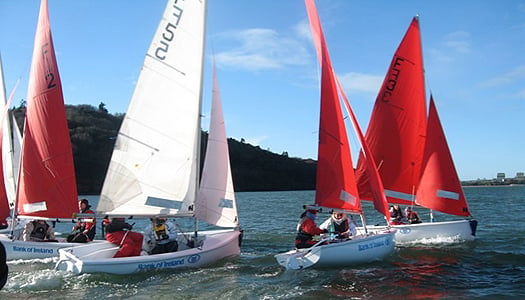
It may be 68 years since Uffa Fox designed the Firefly 12ft dinghy for mass production in hot-moulded multi-skin timber - "cooked life a waffle" - but it is still a favourite for the special demands of team racing, and more durable these days with GRP construction
The TSC season explodes into life this weekend, as the three-day Intervarsities zapped into action promptly at 1000hrs yesterday, with 72 races scheduled each day. Then today both the Tralee Marathon and Half Marathon come trotting through Fenit. And tonight, the club throws its traditional Launch Party, one of the more boisterous events of the year. As Commodore Pat Daly commented earlier this week, after a winter of slumber the members don't know what's going to hit them, but they'll enjoy it anyway.
For sure, they have the place to do it. The rest of Ireland tends to think of northwest Kerry as a wild and woolly place. But in fact Fenit is a snug little spot, with a sheltered south-facing coastline between it and Spa in towards Tralee town, while sailing in the impossibly beautiful bay has been transformed by the top class marina out at the harbour on Great Samphire Island. Yet it's less than an hour's sail across the bay to the Maharees, which is pure Atlantic Ireland, a place apart where they create the finest racing naomhogs on the west coast.
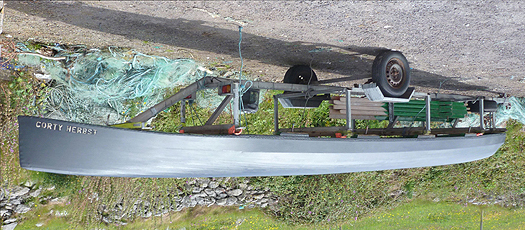
Do not adjust your set....we have inverted this photo, taken July 2012, in order to better show the highly-refined racing naomhog Corty Herbst at the Maharees in Kerry. Corty Herbst (1924-2000) was an American who settled in the Maharees with his wife Joan in 1969, and became much involved with the local racing currachs, playing a key role for many years in organising the Maharees Regatta. Photo: W M Nixon
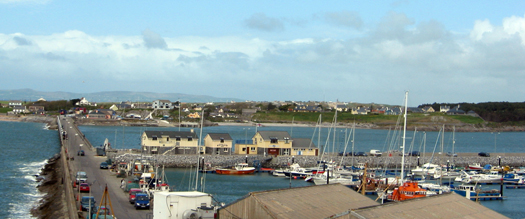
Fenit's 130-berth marina is a friendly place, and the harbour is a fine example of practical co-existence between fishing boats, recreational sailors, and commercial shipping. Photo: W M Nixon
The harbour on Samphire Island is reached along a 0.75 km causeway and bridge which is always well lined with sea anglers, who live in a world of their own. If you arrive in aboard a cruising boat, you'll find it takes exactly seven minutes to walk that bridgeway to the nearest pub, and another couple of minutes to get up to the club. But as the Intervarsities are dinghy focused, everything will rotate around the fine clubhouse in its prominent position above its own launching slip and an excellent sailing area which is ideal for an intense event like this, as it offers several options to cope with changing wind directions.
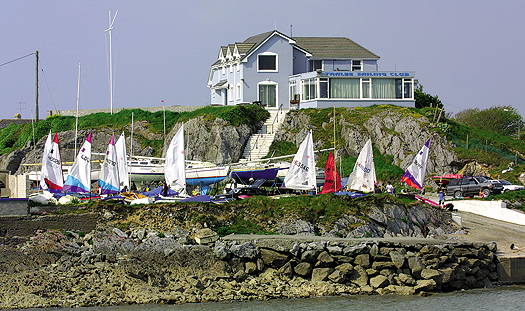
Tralee SC is at the heart of a boat-orientated complex which includes a busy sailing school
Having a major event so early in the season is always a bit of a gamble, but the pattern of the university year dictates the timing. This weekend's series is emphatically the Team Racing championship, which automatically secures the winners a place in the massive British University Team Opens at the end of April. But during April, the Irish colleges will also be in pursuit of a place in the Student Yachting Worlds in France at the end of October, very high on the agenda as UCD won it in 2012, so they already have a place as of right.
Thus there'll be an extra place up for grabs by whoever can top the Irish Worlds trials in April, which will be raced in the SailFleet J/80s. They're based in Howth this year, and the college trials will have racing on April 6th, 13th and 20th. It's all of more than academic interest, as the Student Yachting Worlds will also be raced in J/80s, which provides the prospect of the good old one two for Irish university teams at world level. Dream on.....
As for this weekend, it's the gallant Fireflies which are the workhorses for the three-boat teams. The logistics are mind-boggling, and UL's Robert O'Leary – best known in recent seasons as the helm out of Crosshaven on the family's cruiserfied 1720 Antix Beg – has stood back from being on the team in order to concentrate on the Sisyphean task of keeping things on schedule, or maybe even a bit ahead of the sched, as the winds might be pushing towards gale force northerlies later tomorrow afternoon.
With Irish women being way ahead of their male counterparts these days in success in international sports such as rugby, boxing and sailing, it's no surprise to find several of the leading teams in the Intervarsities on Tralee Bay have women captains, with University of Limerick – very much the pace-setters in college team racing build-ups earlier this year – headed by Lauren Joslin, while the international stars of UCD are captained by Zoe Flood.
Yesterday saw the first day of racing blessed with much better weather than was being been anticipated at mid-week, with Tralee Bay enjoying its own favourable micro-climate while massive clouds passed to north and south in a 12 to 16 knot westerly which was enlivened by only a couple of rainsqualls on the bay. That said, a "small hailstorm" was a reminder that winter has barely released its grip, but there was plenty of sunshine and spring was in the air.
University of Limerick lived up to the promise of earlier events this year with wins in all their races, while UCD were next with five wins out of six, followed by TCD. Today should see the programme moving along with northerlies and clearing skies, and there's an improving chance that the northerly gales being mentioned for tomorrow will be far enough west to allow the programme's smooth conclusion.
GATHERING THE GAFFERS
Trying to assemble a fleet of boats and then get them moving in any sort of co-ordinated way is about as easy as herding cats at a crossroads. It's a good explanation for the appeal of racing – put up a prize and start firing the guns in the starting sequence, and there's just a chance some sort of order might prevail.
Another technique is finding some anniversary of recognisable significance, and building an event around it. The word is that the Irish Cruising Club are going to have a Octogintaquinquessimal Cruise-in-Company in southwest Ireland next year to celebrate the 85th Anniversary of the founding of the club in Glengarriff on July 14th 1929. Anyone suggesting that if they could just hang on for another fifteen years, then they could have a real mega-celebration for the Centenary, is sharply reminded that the club has a very significant membership cohort of extremely senior seniors in a hurry, and they want to Do It Now.
Meanwhile, it seems the notion of a Golden Jubilee cruise this summer for the Old Gaffers Association in the form of a rolling circuit of Britain with two stopovers in Ireland, and boats joining and leaving as they please, is proving popular. Sign-ups for the Dublin visit from May 31st to June 4th have already gone through the fifty mark, with the style being set by some fine big cutters such as Brandaen from the Netherlands, Annabel J from the Solent, and Adrian 'Stu' Spence's 1875-vintage Pilot Cutter Madcap from Strangford Lough.

The impressive Dutch cutter Brandaen has signed up for the Old Gaffers Golden Jubilee Cruise-in-Company, which comes to Dublin Bay from 31st May to 4th June.
It's all a long way from the first assembly in Ireland of boats intent on celebrating the special joys of gaff rig, which attracted precisely three craft to Dunmore East in 1955. For a long time there'd been amiable arguments as to which was the faster boat between the Cork Harbour One Design of 1895, and the similarly-sized Dublin Bay 21 of 1902. With Dinghy Week 1955 being staged in hospitable Dunmore East, a midway port of sorts, two Dublin Bay 21s and two Cork Harbour ODs set out from their respective harbours to meet for the first time ever in Dunmore for a deciding contest which would have the benefit of being witnessed by racing experts.
The weather decided otherwise. Not through gales, but because of an enormous flat calm. In Cork, the two CHODs were towed out of the mirror-like harbour mouth, but the tide brought them back in again, so one of them – Cygnet - moored to a navigation buoy. When the tide turned again to offer the chance of a second attempt at departure, in the hassle of releasing themselves a crewman was left behind on the buoy (I'm not making this up), and the sluicing ebb meant they couldn't return to collect him.
Fortunately George Radley's Querida was further back, and she was able to collect the stranded crewman in passing, so to speak. They made it to Ballycotton that night, and then to Dunmore East the following day. But only one of the Dublin Bay 21s made it over the longer distance from Dublin Bay. This was Naneen owned by Michael 'Styx' O'Herlihy, who the following year sailed to America on the Kearney 6-ton yawl Evora, and made his fortune in the US as producer of the successful TV series Hawaii Five-O. His crew was the youthful Cass Smullen, and it took the pair of them fifty hours to get to Dunmore East, which made Dyko Morris, who retired from the voyage at an early stage with his DB21 Geraldine, even more convinced he'd done the right thing.
With an element of exhaustion and over-exuberant celebration at getting to Dunmore East at all, the actual races don't seem to have been totally conclusive, in fact there were only a couple of contests with one day lost through gales. Honours were fairly even – the Dublin Bay 21 had the edge in lighter breezes when her topsail could be set, but when it piped up the Cork Harbour OD, with her high-peaked gaff main and never carrying a topsail, seemed to have the best of it.
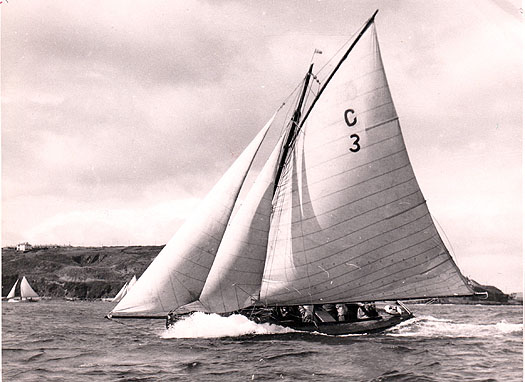
Cork Harbour OD in classic style, with high-peaked gaff mainsail, but no tops'l, romping seaward from Cork Harbour. The restored boats will be having special races at Cobh Traditional Sail Regatta from June 28th to 30th. Photo: Tom Barker
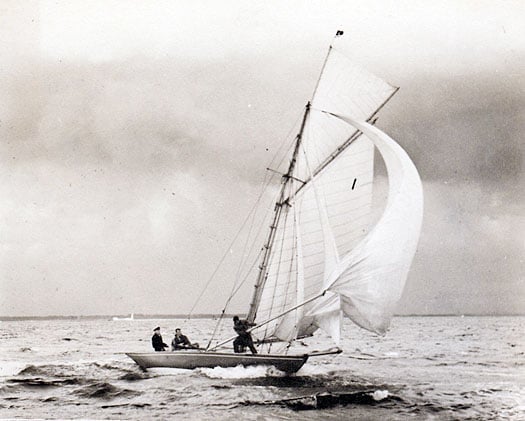
When the Dublin Bay 21 could carry her topsail, she seemed to have the edge on the Cork Harbour OD, but the Cork boat seemed faster in strong winds.
Years later, Styx O'Herlihy and George The Rad used to wax nostalgic about this unique event, for in hindsight it was a sort of last hurrah. In 1963 the Dublin Bay 21s decided to change to Bermudan rig, and at much the same time the Cork Harbour One Designs were being turned into Bermuda rigged cruisers, for which they did very well. They'd heftier hulls than the Dublin Bay 21s, and thus could provide more accommodation, and at a time before bare hulls in fibreglass for home completion as cruisers had become available, it was a useful option for an economy cruiser.
The story takes an odd turn, for although the Dublin Bay 21s stayed together as a racing class, they ceased to function after the damage in Dun Laoghaire harbour by the remnants of Hurricane Charlie in 1986. But the Cork Harbour One Designs found new life as Bermuda-rigged cruisers, and thus survived in order for several of them to be converted back to their original gaff rigged racing setup as the interest in classic yachts grew. Particularly notable was Jap, which was found in a hidden creek of Falmouth Harbour and brought magnificently back to life for Clayton Love Jnr by Fairlie Classics. He notched many classic regatta successes with her before selling her on to David Sheriff, who last year skippered Jap to top boat overall in the Classics Regatta at Cowes in July.

With their conversion to Bermuda-rigged cruisers as seen here in 1981, the Cork Harbour One Designs survived to avail of the classics revival, which has seen several of them restored to original form. Photo: W M Nixon
This year there'll be a chance to see the restored local fleet of Cork Harbour One Designs in action at the Cobh Traditional Sail Regatta from June 28th to 30th. Whether or not we'll see any of them making the scene for the first time ever in Dublin Bay with the Old Gaffer events four weeks earlier is probably mostly a matter of logistics. But if they're heading for the east coast, they can rest assured there's no requirement to leave a crewman behind on a navigational buoy on the way.
Comment on this story?
We'd like to hear from you on any aspect of this blog! Leave a message in the box below or email William Nixon on [email protected]
#SB20 – The first SB20 event was held at TBSC over the weekend of June 30th/July 1st. Although the fleet was small the racing under PRO Peter Moore of the host club was of the highest quality. On Saturady the wind blew fro the NW with a vengeance. Gusts of 35 knots were recorded between the race 1 and race 2 but only 25 to 30 knots during the racing.
Race 1 was won by Ben Duncan's Sharkbait with a flawless display of heavy wind sailing. In race 2 however it was Scott McKeown's Magic who won the plaudits and the race. Two boats retired with damage during the race as the wind and waves took their toll. Sharkbait was the winner of race 3 with Magic in second. At this point the race officer decided that the fleet had had enough punishment for one day and even though it was still early sent them to the showers and the bar.
It was obviously a great party as even though one of the damaged boats reappeared on Sunday morning only eight boats made it to the startline. Conditions could not have been more different as a light and shifty SW breeze made for difficult conditions. Once again Peter Moore did an outstanding job and had three good races on the board by one o'clock with less than ten minutes between races.
Sharkbait made light of the conditions to score three bullets and won the last race of the event by an enormous margin to take the title with five wins and a second as a discard. In the Silver Fleet Ronan Downing recovered from a poor first day to take first and fourth overall.
Sail No Boat Owner Race 1 Race 2 Race 3 Race 4 Race 5 Race 6 Net Place
3287 Sharkbait B. Duncan 1 2 1 1 1 1 5 1
3490 Dinghysupplies S. Murphy 3 7 3 2 4 2 14 2
3198 Magic S. McKeown 2 1 2 6 6 7 17 3
3 Manamana R. Downing 10 8 4 4 3 3 22 4
3433 Boatmec.com D. Taylor 4 6 5 3 8 5 23 5
3449 Lia D. Barry 5 5 8 5 5 4 24 6
3338 MilvusMilvus R. Howe 8 4 7 7 2 6 26 7
3537 Boomsticks B. Reilly 6 3 6 11 11 11 37 8
35 R. Tate 7 11 11 8 7 8 41 9
3307 Bad Kilcullen J. Dowling 9 11 11 11 11 11 53 10
Tralee's Sophie Browne is January Sailor of the Month
#SAILOR OF THE MONTH – Sophie Browne of Tralee Bay and Royal Cork is Afloat.ie/Irish Independent "Sailor of the Month" for January after taking the Silver Medal in the Girls Division in the Optimist Worlds in New Zealand. She added it to the Gold in the Girls, and fourth overall, which she won from an enormous fleet in the last major European regatta of 2011, at Palma, Mallorca in December.

Sophie in action abroad in Palma (top) and at home
It's some going when you're just fourteen. Sophie is back at school now, trying to make up for lost study time. But if she gives it the same total dedication she put into each sailing campaign during recent years, she'll sail into a good leaving cert in due course.
Dedication is the name of the game, and the Browne family in Tralee are a byword for it. Normally, the adjudicators for the Sailor of the Month are very reluctant to make the award to the most junior helms. They grow up so quickly, there's something ephemeral about it all.
But even at only fourteen, there's nothing ephemeral about Sophie's success. Other kids may think too much about the glitzy side of championships, but Sophie Browne is well aware of the sheer hard work and unglamorous dedication which goes into that podium place.
After the big regatta in Palma in December, the European Optimist squad went out to New Zealand with high hopes. But the pre-Worlds and the Worlds were salutary experiences. Thoughtful observers were well aware of the rising talents of southeast Asia, and South America too, as well as New Zealand and Australia, but for most it was a daunting learning experience.
It's Singapore which is most clearly setting the pace. Kimberly Lim from the vibrant city-state was both top girl, and the new world champion. Sophie Browne was second in the girls, but was back in 13th overall. Yet she was still one of the best of the Europeans – the top British sailor, for instance, was back in 21st.
It's the first time a 14–year old helm has taken the monthly sailor title. We've had younger sailors sharing a title as crews on a Mirror dinghy, but this is the first driver. And we're certain sure it won't be the last we'll hear of Sophie Browne of Tralee Bay in international sailing.
Safari Boats Order Boosts Kerry Boat Building Firm
Kerry Boat-builder O'Sullivan's Marine (OSM) is bucking the trend in the depressed marine industry. The Tralee firm have a busy order book and report strong demand for its traditional lake boat marque but it also has interest in more exotic boats too for the emerging nature tourism market.

Tried and tested, the new Safari boats are ready for Lee Valley
The first of the orders processed in Tralee is the supply of four Pioner Multi boats with Motor Guide 24v Electric Outboards for the local Lee Valley Development, a new eight hectare (20 acre) eco-tourism development comprising a Nature Park. The four boats will be used for safari-style boat rides.
'We carried out water trials yesterday, all is in order and the fully fitted out boats are being delivered this week', says managing director Brian O'Sullivan.

OSM's Brian O'Sullivan with one of the new Pioner boats
OSM, a member of the Irish Marine Federation, is also supplying two lake boats to Creeslough Angling Association in Donegal. Six Irish built boats have also been ordered by Dunfanaghy Angling Association in Donegal. Five more lake boats are also going to Waterville, Co. Kerry. All orders are for November delivery! Recession? What recession?
OSM have a selection of used craft on the boats for sale website. See them here
Fenit Name New Lifeboat in Memory of Bangor Couple
A brand new RNLI inshore lifeboat was officially named 'Bradley and Sonya' during a moving ceremony on Saturday 25th September at Fenit which is located on north side of Tralee Bay on the far south west coast of Ireland. The new D class lifeboat was named in memory of a young couple, Bradley and Sonya Burns from Bangor who were lifeboat volunteers and who died within 10 months of each other in 2006.
Volunteer lifeboat crew with Bangor RNLI raised £34027.48 to fund the lifeboat as a tribute to the young couple.The lifeboat was named by Mrs Mary Connolly and Mrs Eileen Savage, the mothers of Sonya and Bradley, while Sonya's sister Judy Connolly and Bangor lifeboats Senior Helmsman Kyle Marshall delivered the lifeboat into the care of Fenit RNLI. Fourteen members of Bangor lifeboat crew attended the ceremony along with members of the couple's family and lifeboat volunteers from around the coast.
Speaking during the ceremony Judy Connolly said, "Whilst we will never forget Bradley and my sister Sonya it is some comfort to know their legacy lives on, doing what they did so well – working to save lives at sea. We are delighted that this modern new lifeboat will make a real difference to the search and rescue capability in the Kerry area. Tragedy is never far from the sea and I do hope that it will be the instrument to save many lives."
Lifeboat Operations Manager with Fenit RNLI Gerard O'Donnell added, "We are extremely grateful to the crew at Bangor lifeboat station for their generosity in funding the new lifeboat. On behalf of the lifeboat crew in Fenit I offer our sincere thanks. This improved lifeboat will allow our volunteer crews to respond more quickly in emergencies and may well make the difference between life and death for someone in trouble in the water. "
Kyle Marshall, Senior Helmsman on Bangor lifeboat commented "It is a truly fitting honour and legacy to the memory of our dear friends Bradley and Sonya; they gave so much to the RNLI." Kyle went on to say "The generosity and support from the people of Bangor, from others further afield and from within the RNLI family has been overwhelming. So many individual people, groups and companies have selflessly given of their time, effort and money to fund this new Fenit lifeboat. We at RNLI Bangor Lifeboat wish to express our heartfelt thanks to everyone who made the funding of this new lifeboat possible"
The Bradley and Sonya lifeboat will join Fenit's all weather Trent class lifeboat Robert Hywell Jones Williams.
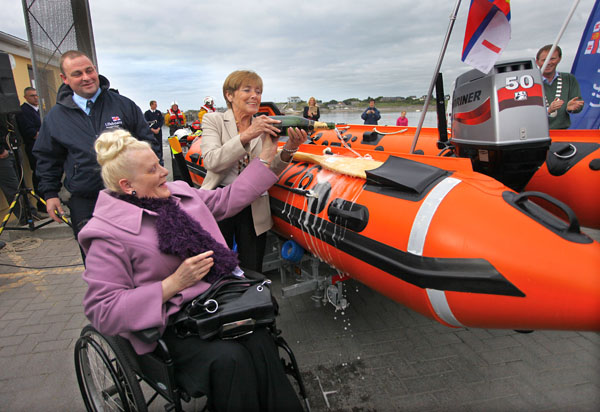
Mrs. Mary Connolly (Sonya's mother) and Mrs. Eileen Savage (Bradley's mother) name RNLI Fenit lifeboat 'Bradley and Sonya'
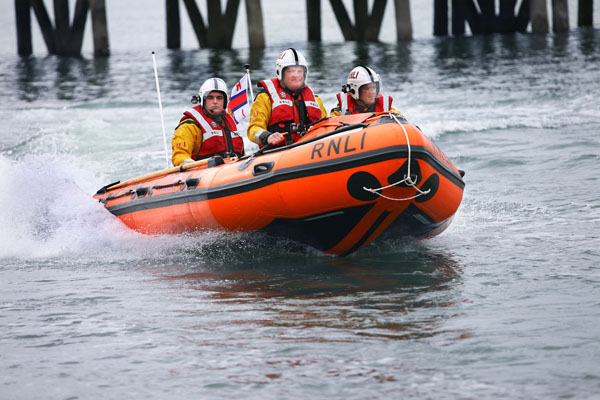
Fenit Lifeboat in action. The RNLI D class lifeboat is 5 metres in length and has a maximum speed of 25 knots. Photos: Valerie O'Sullivan
Related Safety posts
RNLI Lifeboats in Ireland
Safety News
Rescue News from RNLI Lifeboats in Ireland
Coast Guard News from Ireland
Water Safety News from Ireland
Marine Casualty Investigation Board News
Marine Warnings





























